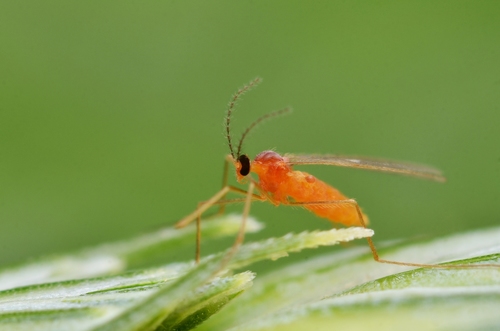Wheat midge (Sitodiplosis mosellana)
Biology and life history: The wheat midge (or orange wheat blossom midge) is a serious wheat pest in the Northern Great Plains, USA and Canadian provinces, and in parts of the Pacific Northwest. It is a small fly (0.08 to 0.12 inch), with an appearance similar to a mosquito. It is orange-colored, with conspicuous black eyes, long legs, and oval, transparent, fringed wings. The adult can be seen sitting on wheat heads with the head facing upwards. The female lays eggs on wheat awns and heads and the larvae feed on the developing grain, damaging the kernels. In size, shape, and color, the larvae look similar to the wheat anthers.
Host plants and crop damage: Wheat midge primarily feeds on spring wheat, but it also occasionally attacks winter wheat, barley, couch grass, intermediate wheat grass, rye, and other grasses. Feeding of wheat midge larvae damages the developing wheat kernel causing it to shrink or crack and reducing the quality and quantity of harvested grain. Since feeding by the midge on the wheat head can occur partially and only on some kernels, the damage may not be readily apparent, without careful inspection.
Management: There is no established economic threshold or integrated pest management guidelines specifically for wheat midge in the Pacific Northwest. However, growers can use the thresholds used in other states (e.g., North Dakota; 1 midge per 5-7 heads of spring wheat). During wheat heading and flowering, growers regular scouting for midges is recommended during calm, clear evenings with warm temperatures, as the female prefers laying eggs during these conditions. The midge is usually inactive until the dusk. Plate, sticky, emergence, or sex pheromone traps are used to monitor adult wheat midges. Biological control of midges by parasitic wasps have been reported to be effective. To break the pest cycle and manage midge populations, growers can adopt cultural methods such as rotating crops (e.g., oilseeds, legumes, or other cereal crops, instead of continuous wheat cropping), and adjusting seeding dates (e.g., early seeding of spring wheat), or planting midge resistant cultivars. If the midges are present in large numbers but no other management tool is effective in controlling them, safer insecticides can be applied. Frequent application of broad-spectrum insecticides kills natural enemies.

